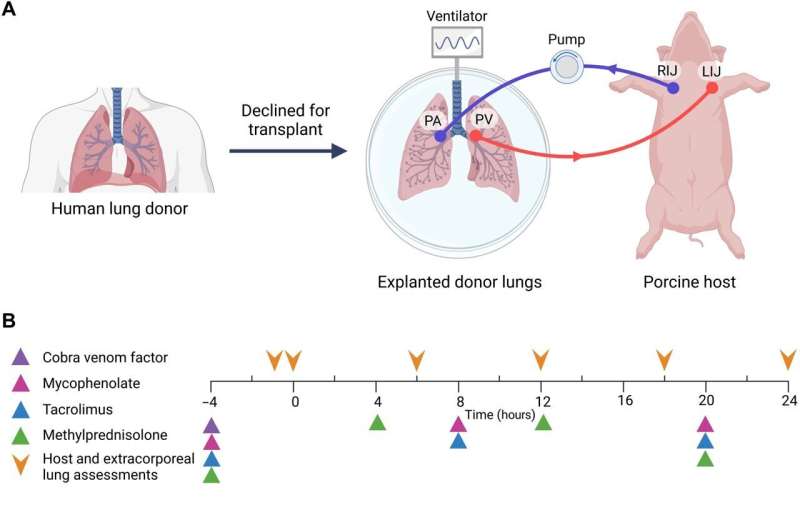April 4, 2023 report
This article has been reviewed according to Science X's editorial process and policies. Editors have highlighted the following attributes while ensuring the content's credibility:
fact-checked
peer-reviewed publication
trusted source
proofread
Pig blood and cobra venom used to increase human lung transplant viability

Medical researchers at Vanderbilt University Medical Center, Nashville, have found a way to maintain donor lung viability for transplantation. The method was even shown to return viability to transplant tissues that would otherwise have been deemed too damaged to use. The technique could substantially increase the ratio of donor-to-recipient transplants, saving lives and speeding access to treatment.
In the paper, "Immune characterization of a xenogeneic human lung cross-circulation support system," published in Science Advances, the researchers detail how they kept lungs viable for 24 hours.
In the introduction of the paper, the authors point to the low rate of donated lung use, citing estimates that only around 25% of lungs taken from donors make it to recipients. The study references time as the main obstacle, as even the best lung preservation methods have just a six-hour window for the transplant to take place. Beyond this time frame, the lungs begin to acquire damage that makes them ill-suited for the already difficult task of implantation in another human.
Pig blood to the rescue
The researchers developed a cross-circulation method of connecting the circulatory system of a living pig to the removed donor lungs. The method is not unlike what takes place during some open-heart surgeries, where a blood donor's circulatory system is connected to that of the patient providing oxygenated blood in a real-time transfusion.
The researchers showed that their method not only works to keep the viability window open longer but also supports the viability and functional recovery of human donor lungs that would otherwise be declined for transplantation.
While the lungs were healthy enough for a transplant, another problem presented itself. There is already a strong donor rejection response in transplant recipients, and the pig-blood-preserved lungs were found to be rich in cellular infiltrates and deposits of pig antibodies.
Cobra venom will make it better
Researchers neutralized the pig blood deposited immunoglobulin in the lungs using cobra venom factor, a nontoxic protein in the venom from the cobra species Naja kaouthia. Previous research has found that this cobra venom component protein is a much more stable analog of a protein found in the human immune system. Where the human version (complement C3) lasts for a few minutes at most, the cobra venom factor remains stable for several hours, making it ideal for this application. Still, having piggy antibodies in donor tissue is not ideal.
After 24 hours of the xenogeneic cross-circulation, donor lungs maintained the preservation of global architecture and showed improvements in appearance and recruitment of consolidated segments. The lungs actually improved in overall viability for transplant over time, the opposite of what is seen in typical transplant preservation techniques.
Future research will look to improve upon this impressive proof of concept. One possible direction the authors are interested in is the possibility that genetically immunodeficient pigs could be developed for the express purpose of being transplant chaperones to avoid the antibody intrusion issue.
More information: Wei K. Wu et al, Immune characterization of a xenogeneic human lung cross-circulation support system, Science Advances (2023). DOI: 10.1126/sciadv.ade7647
© 2023 Science X Network



















